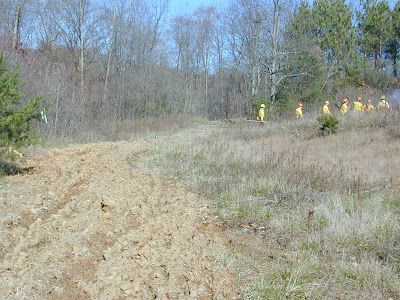In 1997, while exploring part of our land lab known as the Conference Center, I noticed about 5 prairie species doing well in this abandoned pasture. It turns out a few seeds were spread back in the 1980's and were left to do their thing.
After the area had been ignored for so long, Don Althoff, now a wildlife management professor at Rio Grande College, talked about the potential of the area. So we decided to implement a full blown prairie management plan. The foreground area of the picture would be used for wildflowers.
The long strip of land would then be planted with various grass species. In the spring of the year we first weed whacked any woody plants coming up. Then we planned to burn the area. Fires have always been a natural process that maintained the prairie by killing any invading trees and shrubs.
Using students and faculty from the Prescribed Burning class, we first plowed a fire break to insure the burn stayed within a designated area. While I have no pictures, I should mention we plowed and disced the ENTIRE area before our first planting.
Drip torches are used to start the fire. Several burn methods exist, and we used the safest one known as strip burning. The torch person goes back and forth through the area. This method has one line of fire burning right into the other. Because of the danger, you must have a red card to fight fires, and even more certification to be an ecological burn boss.
Here you can see the undesirable woody plants as the fire goes through.
Woo-hoo!! pyro heaven! Now it's getting good. I've been on burns where there are no buildings or people nearby to worry about, and we'd let the flames reach over 20 feet in the air. On a small area like this, you try to keep flames under 10 feet.
This was a nice hot fire. So hot in fact, even the water hose jumped up and went Ow Ow Ow! ha ha
Whenever you burn, always notify the neighborhood as to what is going on. Also have a fire truck standing by just in case. That's Mark Puhl, our fire boss, who has been teaching fire classes for many years here.
"Oh those hair-brained ecologists, they let everything die". That's what the politicians said back in 88 when Yellowstone caught fire. But if you understand the science, it's the best thing that can happen. Prairie plants in particular may spend several to many years growing roots underground before they ever bloom. In case a fire goes through, they have a large nutrient base already stored up, and simply resprout. We burn this area every 3-4 years to knock back invading trees, which allows prairie species to dominate more ground.
On the left is a hay field, mowed on a regular basis. On the right is a prairie where no mowing occurs. You can establish a small prairie fairly easy, even on just one acre. This is on our Lake Snowden property.
Another comparison picture. On the right is a one year old prairie. The Queen Ann's Lace is still prevailing. The left is a 2-3 year old plot. You can see by now the prairie species have taken over. This was from the 90's at a metro park near Columbus known as Darby Creek.











No comments:
Post a Comment